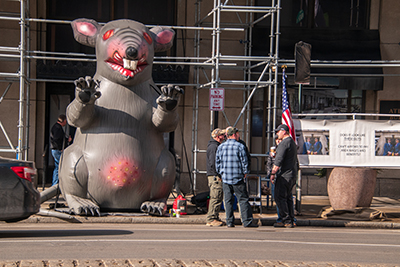The National Labor Relations Board (NLRB) is pondering a gnawing question: When might the display of a 12-foot inflatable rat with blood-red eyes and jagged teeth violate the National Labor Relations Act (NLRA)?

On October 27, the Board announced it was seeking input in a case involving a union’s use of the inflatable dubbed Scabby the Rat as part of a protest at an RV trade show. The case is International Union of Operating Engineers, Local Union No. 150 (Lippert Components, Inc.), 370 NLRB No. 40.
Scabby and two large banners were displayed on public property near the entrance of the RV exhibition to show a union local’s complaint against Lippert Components, Inc., a company manufacturing RV parts.
An administrative law judge in July 2019 found the union’s display at a neutral site—the trade show rather than at the company—did not violate Section 8(b)(4) of the NLRA. But NLRB General Counsel Peter Robb is urging the Board to look again at the cases that led to the judge’s decision.
In a notice and invitation to file briefs, the NLRB says Robb contends that in those cases, the Board “narrowed the definitions of picketing and coercion, created standards that were ‘vague and imprecise,’ strayed from ‘the dictates of Section 8(b)(4),’ and departed from ‘decades of Board law.’”
Display Coercive?
Charles H. Kaplan, an attorney with Hodgson Russ LLP in New York City, points out the NLRA prohibits a labor union from picketing an employer in support of a secondary boycott.
The NLRB’s call for input says that although a union can’t “picket” a neutral secondary employer, previous Board cases have held that displays of stationary banners are lawful because they aren’t on par with picketers patrolling an entrance and don’t directly disrupt or threaten to disrupt the neutral employer.
Kaplan says the NLRA and the First Amendment to the U.S. Constitution allow a union to distribute handbills at the secondary employer’s site because handbilling “is not ‘coercive’ in the same manner that a picket line is.”
Kaplan says Robb “has taken the position that a union’s use of an inflatable rat outside a secondary employer is tantamount to unlawful secondary picketing, arguing that it is unlawfully coercive to other workers.”
The NLRB has previously found, however, that the use of the rat is not the same as a picket line, Kaplan says. “Further, at least two federal circuit courts have determined that a union’s deployment of an inflatable rat is free speech that the First Amendment protects,” he says.
“If the NLRB holds that a union’s use of an inflatable rat is unlawful, it is likely that the decision will be appealed and that the U.S. Supreme Court will need eventually to rule on this issue,” Kaplan says. “Because of the tension between the NLRA’s prohibition of secondary boycotts and the First Amendment’s protection of free speech, it is not clear what the Supreme Court will ultimately determine.”
If the NLRB ends up changing its standard on what’s acceptable under the NLRA, Stephanie Gournis, an attorney in the Chicago office of Faegre Drinker Biddle & Reath LLP, says employers “likely would cheer the timely death of Scabby the Rat,” but as a practical matter, “Scabby the Rat serves more as a distraction than a real differentiator in union campaigns.”
“Unions likely will create another attention-grabbing communication gimmick if the NLRB takes away their right to blow-up cartooned rats,” Gournis says. Also, as with other changes under President Donald Trump’s NLRB, she says “any significance will be short-lived in the event of a shift in White House administration,” and Scabby’s real fate likely will be decided in the federal courts.
The NLRB’s invitation for briefs on the subject is the latest effort to possibly scale back previous actions related to what is and is not permissible. Matthew H. Parker, an attorney with Whelan Corrente & Flanders LLP in Providence, Rhode Island, points to recent Board guidance related to civility codes as one example of how it is giving employers more leeway than what they had during the previous administration.
Also, there’s an effort to make it easier for employees to vote to decertify a union during periods of time that are currently considered off limits, Parker says. If the Board ends up reining in the use of Scabby the Rat, it will be one more blow to unions.
“It will remove one tool that unions use to sort of rally the troops or antagonize management,” Parker says.
NLRB’s Questions
In the notice and invitation to file briefs, the NLRB seeks input on the following questions:
- Should the Board adhere to, modify, or overrule previous cases that set the current standard? Those cases are Carpenters Local 1506 (Eliason & Knuth of Arizona), 355 NLRB 797 (2010), and Sheet Metal Workers Local 15 (Brandon Regional Medical Center), 356 NLRB 1290 (2011).
- If you believe the Board should alter its standard for determining what conduct constitutes proscribed picketing under Section 8(b)(4), what should the standard be?
- If you believe the Board should alter its standard for determining what nonpicketing conduct is otherwise unlawfully coercive under Section 8(b)(4), what should the standard be?
- Why would finding that the conduct at issue in the Lippert Components case violated the NLRA under any proposed standard not result in a violation of the respondent’s First Amendment rights?
Tammy Binford writes and edits news alerts and newsletter articles on labor and employment law topics for BLR web and print publications.
